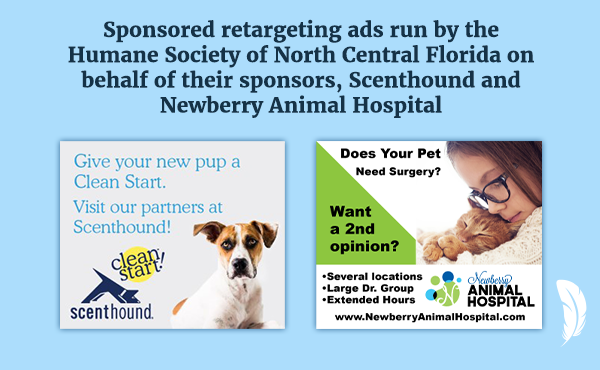
Nonprofit Advertising | Approaches, Examples, and Tips
Have you ever purchased a piece of clothing, a home decor item, or a goofy “White Elephant” holiday gift from an ad you saw on social media? Or, maybe you heard an announcement on your local radio station about an upcoming concert and immediately went home to buy tickets.
If you can relate, you’re one of many people who have encountered and responded to advertising. These campaigns are sprinkled throughout our daily lives and we encounter them all the time — on average, we actually see somewhere between 4,000 to 10,000 ads every single day!
Marketing and advertising have become big industries in the for-profit space, but nonprofit organizations can benefit just as much from a well-crafted advertising strategy.
In this guide, we’ll cover approaches, examples, and top tips for nonprofit advertising by covering the following topics:
- A bird's eye view of nonprofit advertising.
- Why nonprofits should invest MORE in advertising.
- Advertising ideas for nonprofits.
- Nonprofit advertising examples to inspire your team.
- Tips to improve your nonprofit advertising campaigns.
An overview of nonprofit advertising
Nonprofit advertising broadly refers to the activities and channels that an organization uses to spread the word about its cause. A lot of people have a bad taste in their mouth from for-profit advertising (think of all those commercials we have to get through), but in the hands of the right people, advertising can actually be a force for good.
Nonprofit marketing describes all of the activities an organization completes in order to promote its brand and cause, including but not limited to tasks like conducting donor research, hosting events, launching email campaigns, and planning advertising campaigns. On the other hand, nonprofit advertising describes just one aspect of marketing, specifically the paid campaigns that your nonprofit uses to promote your cause.
While most nonprofits have a marketing and communications strategy, they may be hesitant to incorporate a concentrated advertising strategy into the mix. That’s because of the aforementioned “paid” aspect of advertising. Not only do these organizations naturally shy away from any type of overhead, but they may also not know how impactful nonprofit advertising can be.
Here are just a few questions that many nonprofits ask themselves as they begin to consider advertising their cause:
Can nonprofits use advertising?
Yes, nonprofits are allowed to dedicate a portion of their budget to advertising.
The portion that they dedicate will need to either come from unrestricted funds, meaning that they can use it for any operating purposes, or restricted funds given for the purpose of improving their marketing strategies (such as an advertising-specific grant like the Google Ad Grant).
The key is that any funds that a nonprofit spends toward advertising need to be clearly tied to positive outcomes for the organization.
Nonprofit marketing professionals may measure advertising success based on donations raised, event registrations, volunteer registrations, or whatever other goals the nonprofit is using the advertisements to achieve. As long as the advertising spend can be clearly linked to an organization benefit and a positive ROI, it’s a worthwhile expense.
How much do nonprofits pay for advertising?
The amount that a nonprofit pays in advertising can vary widely depending on the organization’s size and goals.
A recent study found that approximately 60% of the nonprofits surveyed had budgets dedicated specifically to advertising. Of those organizations, the median annual advertising spend was $12,000.
We surveyed our own community and found that over 50% planned on increasing their advertising spend while only 7% planned on decreasing that spending. It's working for those who have jumped onboard!
It’s important to note that not every nonprofit needs to spend $12,000 to achieve great results. In fact, often a couple hundred dollars can make an impact for a smaller nonprofit!
What are the biggest challenges with nonprofit advertising?
Because nonprofit advertising is a paid effort, organizations tend to run into a few recurring challenges:
- Hesitance to dedicate funding to advertising. Due to the nature of nonprofit work, organizations (and their supporters) want to direct as much of their funding to programs. Advertising budgets often have the goal of raising awareness of the nonprofit and its cause to generate more revenue, which makes it appear as an overhead expense. While it does eventually impact the mission, it does so by helping the organization itself grow. Some nonprofits hesitate to dedicate sufficient funding to advertising and choose to instead funnel that revenue toward existing programs rather than growth.
- Limited budget to dedicate to advertising. Even those nonprofits that decide to dedicate funds toward advertising often dedicate too little. This means that many nonprofits are working with smaller-than-ideal advertising budgets. This can limit what the organization is able to accomplish with their advertising, especially if they’re also new to running campaigns.
- Lack of awareness around their target audience. When a nonprofit isn’t familiar with the target audience for its advertising campaigns, it could end up targeting ads to individuals who are unlikely to engage. Or, they could end up sending ads that don’t resonate with the audience they’re targeting, making the ads unconvincing. This can lead to wasted advertising spend for nonprofits already working with tight budgets.
While the paid nature of advertising can create hesitations for some nonprofit professionals, there is a clear argument to be made for continued investment in these campaigns.
Why nonprofits should invest more in advertising
Even if your nonprofit is facing the challenges mentioned in the previous section, there are strong reasons for increasing your organization’s advertising budget. Without advertising, you won't be able to:
- Increase the reach of your nonprofit and mission. With effective advertising campaigns, you’re able to target new audiences that your nonprofit hasn’t yet engaged with. This could be in new geographic locations, new demographics, or another market you're wanting to capture. Ad campaigns also allow you to target those new audiences in a smart way — by sending ads to those who have a high likelihood of converting. An especially effective campaign is a donor abandonment campaign, where you send ads to those who already reached your donation page.
- Achieve major returns on low-cost efforts. With digital advertising, you can spend a few hundred dollars on a campaign and raise thousands on behalf of your nonprofit in return. Because you have the ability to segment your audience and target those who have the highest chance of engaging with your cause, you’ll increase the likelihood of engaging new supporters while retaining existing ones.
- Automate your campaigns. With digital advertising, you can set your campaigns up and leave them for the duration of the effort. Some digital advertising platforms allow you to fully automate parts of the process, saving your team valuable time. For example, you might set up automated ads to appear for supporters and prospects who abandon your website. This recaptures them with only front-end time invested from your team.
Many solutions also enable your nonprofit to set a budget for your ad campaigns, never spending more than intended while still reaping maximum results. While it can be nerve-wracking to incorporate advertising into your nonprofit’s budget, especially for smaller organizations, it’s a worthwhile investment.
Advertising ideas for nonprofit organizations
Once you’ve decided to incorporate dedicated advertising efforts into your nonprofit’s budget, you'll then need to decide which tactics will lead you most effectively to your goals.
While each of the following channels can be used independently, the most effective nonprofit advertising strategies incorporate multiple tools in a multi-layer, or omnichannel, marketing strategy.
Retargeted advertising
Retargeting is a digital advertising strategy that serves ads to individuals who recently visited your website. Research has shown that retargeted ads are 70% more effective than standard display advertisements, as they remind your prospective supporters of a page that they’ve already expressed interest in.
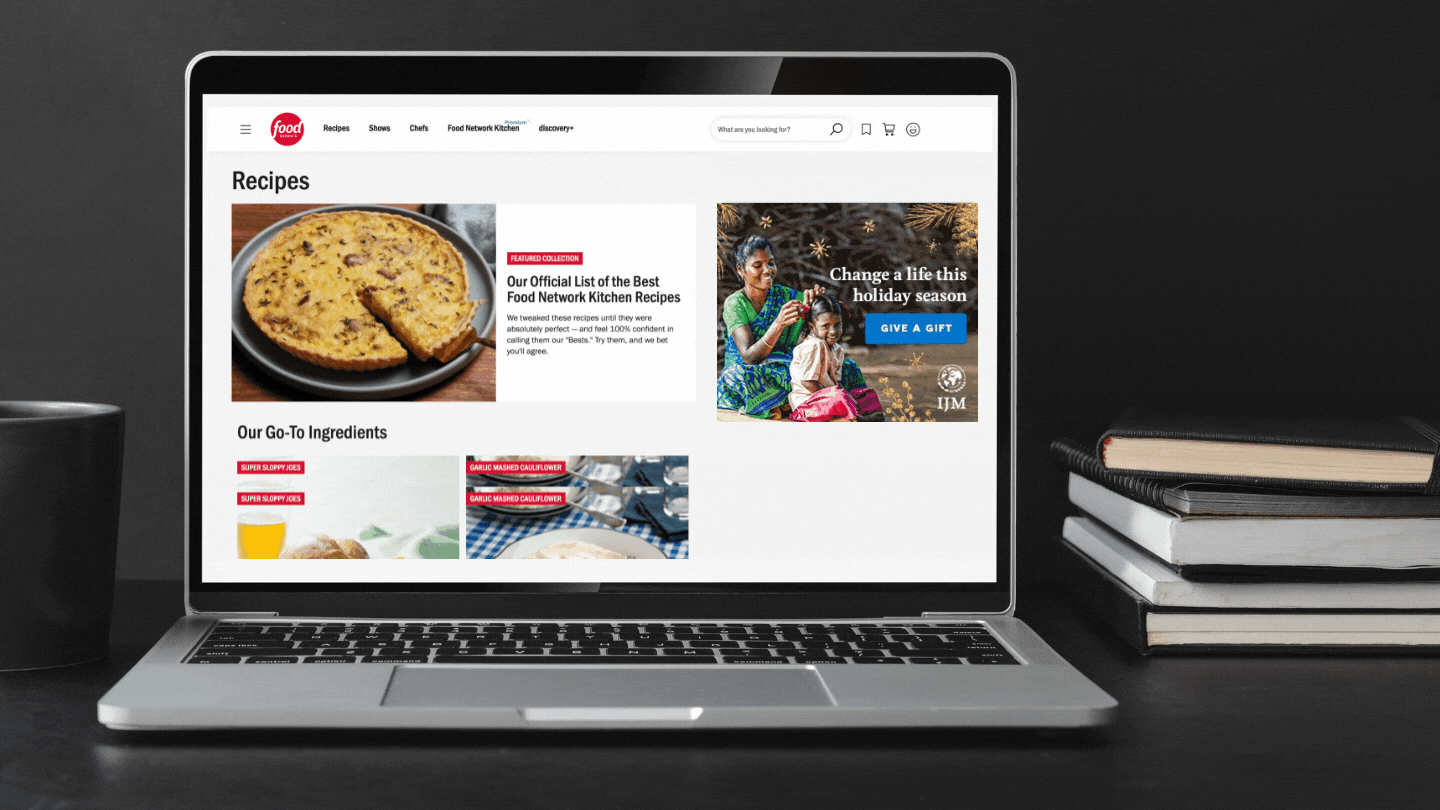
Let's break down the retargeting process:
- A prospective supporter visits a specific page on your nonprofit’s website like the homepage, about, or donation page.
- They leave the landing page and your website overall, navigating somewhere else or closing down their browser entirely.
- When they visit another website, they see an ad in the sidebar or middle of the page that points back to the page they left on your nonprofit’s site.
- They follow the advertisement back to your website and complete the desired next action.
For example, let’s say that you’re promoting an upcoming fundraising event where supporters register on an online form. While some supporters register for the event immediately on their first visit to your online registration page, others click away without signing up.
With ad retargeting, the supporters who click away from the event landing page will be served ads pointing back to it as they continue browsing the web. After a few impressions, they may follow an ad back to the landing page and register for the event.
Google Ads
Google Ads are the text-based ads that are displayed to users at the top of a Google search result page.
For any given search inquiry, Google will place anywhere from one to four paid advertisements at the top of the search engine response page (SERP). These ads look nearly identical to organic search results, except for a small “Ad” signifier that shows up on the left side of the link.
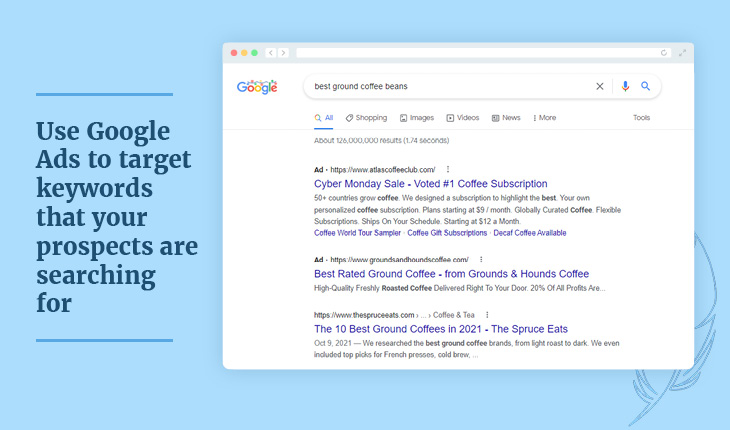
These ads are tied to specific keywords or the terms that Google users are searching for. Essentially, organizations can bid on specific keywords that are most applicable to their organization’s target audience. If they win the keyword, the nonprofit can pay a fee to have their ads shown at the top of the SERP each time an individual searches for that term.
For example, if your organization is a food bank that serves a specific county, you could purchase paid advertisements targeting the keywords “[Name of County] Food Bank” or “How to donate food in [Name of County].” Then, Google users who are searching for this keyword would be served your nonprofit’s ads as one of the first search results.
Social media advertising
Social media advertising describes the ads shown to social media users as they scroll through their feeds.
Social media platforms host a wealth of information about individuals who are signed up on their sites. The platforms contain information about users’ names, employers, work history, interests, location, and more.
You can leverage this information to reach new people who resemble your current donors, making your awareness campaigns more effective.
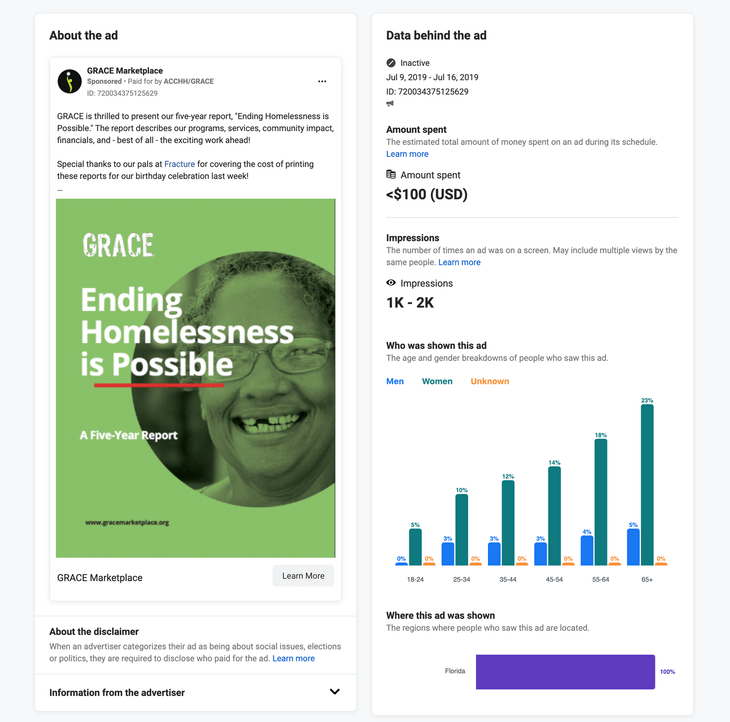
Nonprofits can feature social media ads on all of the major platforms, including:
- Facebook, which can feature more traditional graphics-based ads, full promotional posts, and video ads shown before video content.
- Instagram, which can feature promotional posts and stories in both image and video formats.
- LinkedIn, which shows ads as promoted posts.
For each network, you can choose the target audience to which you’d like your nonprofit’s ads to be shown.
The process of purchasing these ads varies depending on the social network that you’re using. Let’s consider Facebook Ads as an example.
The platform allows you to choose the objective you want to accomplish with the ads, create a custom audience to target, define where you’d like ads to appear (ex: Facebook, Instagram, Messenger), set the budget you’d like to spend per day or over the entire course of the campaign, and choose which of six formats you’d like to use for the layout of your ads.
Sponsored retargeting
Sponsored retargeting describes ads that are purchased by an organization or business that sponsors your nonprofit.
Sponsored retargeting ads can act as a funding source for a nonprofit. These advertisements can be co-branded, meaning they feature messaging and the main branding elements of both your nonprofit and the sponsoring organization or they could simply promote the sponsor’s business to your audience.
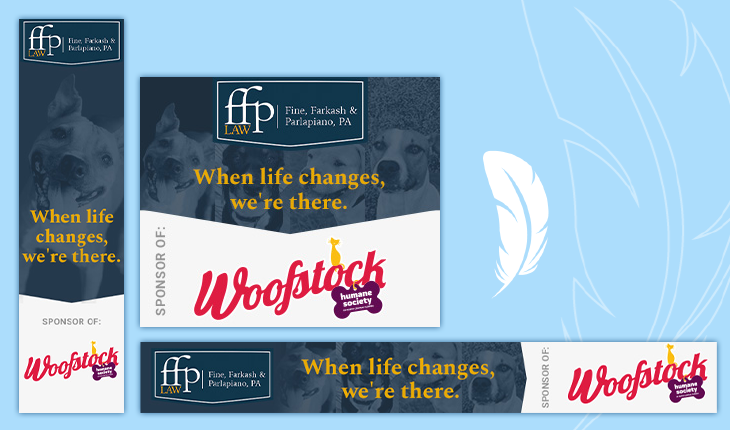
Examples of sponsored ads from the Humane Society of North Central Florida with their sponsor, FFP Law.
A company may purchase sponsored retargeting for two reasons:
- They want to be associated with your nonprofit and its positive reputation.
- They serve a similar audience to your nonprofit and want to market directly to your audience (which they don’t have access to).
Keep in mind that these benefits go both ways! When nonprofits and businesses are closely aligned in their interests and industry, they can support each other. A business supports a nonprofit by purchasing the ads and the sponsor gets the opportunity to reach your audience.
For example, a local humane society could partner with a pet-related business in their community. The business could purchase sponsored advertisements from the nonprofit during the holiday season — a period which often has high dog adoption rates — to share information about their services to new owners.
From there, the local humane society would then run the sponsored ads targeting its audience, allowing the business to get in front of the nonprofit’s supporters.
Influencer advertising
Influencer advertising describes ads that are created in partnership with an influential individual in your nonprofit’s orbit — whether a board member, executive director, local celebrity, or politician.
These influencers are experts in a specific topic or field, and they’ll have individuals flocking to “follow” them because of it. When an influencer promotes a campaign on behalf of your organization, it allows you to gain traction with their audience as well.
With influencer advertising, your nonprofit can tap into the influencer’s existing audience of support and do so from a reputable standpoint — after all, they already trust the influencer, who will be advocating on behalf of your organization.
Ask important board members, stakeholders, event speakers, and other important members at your organization to set up pages to promote your latest campaign. Then, ask them to share that page with their followers.
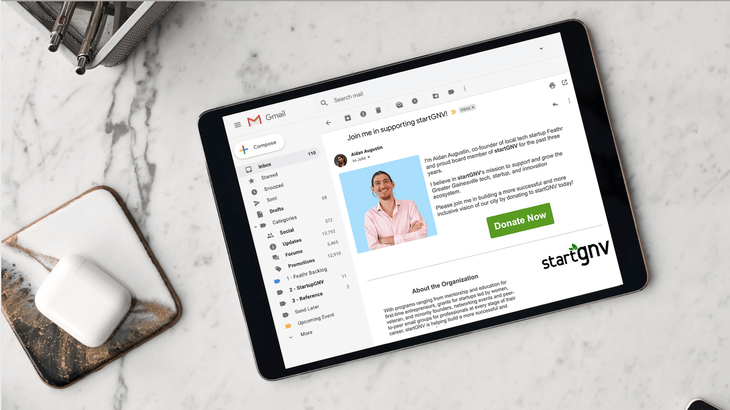
For example, perhaps you’re hosting a large fundraising event in the near future and you’ve booked a well-known speaker to deliver the keynote address.
With influencer advertising, you’d create co-branded collateral that makes it easy for the influencer to spread the word about the event and their involvement in it. Leading up to the event, they’d share this collateral across the various channels mentioned above, and direct individuals to your nonprofit to register for the event (or make a donation in support!).
Nonprofit advertising examples to inspire your team
We’ve discussed the various types of advertising campaigns that your nonprofit can run in theory — but what does this look like in practice?
Here are a few examples of nonprofit organizations that saw major returns through their advertising investment.
International Justice Mission
Like many nonprofits, International Justice Mission (IJM) was facing a bleak year-end fundraising landscape in 2020 due to COVID-19. This put the nonprofit’s yearly Holiday Gift Catalog fundraiser, a campaign that raises funds for humanitarian causes around the world, at risk.
To combat potential decreases in fundraising, IJM used Feathr to launch three ad campaigns about the Holiday Gift Catalog. These advertising campaigns were each a little different. One used retargeting, one used email mapping (or targeting individuals on the nonprofit’s email list), and one used keyword search (or targeting individuals who search for terms closely related to the fundraiser).
Jared Arango, the regional lead for paid media at IJM, said, “For 2019's Holiday Gift Catalog, IJM only had one main Feathr campaign, which was focused on retargeting anyone who had visited IJM.org with a Holiday Gift Catalog ad. This year [2020], we did a similar retargeting campaign, but we were able to incorporate additional creative assets. We did email mapping as well, and we also used a search keyword campaign to target people who had searched things around ‘gifts that give back’ or ‘charitable gifts’ and other things people might be searching around the holiday season.”
The nonprofit spent about $7,000 on the three campaigns, but achieved the following as a result:
- $109.5K donations raised.
- $1,563% return on ad spend.
And all of this took place in just seven weeks.
Key Takeaway: Combining multiple campaigns allows you to reach a larger audience.
American Epilepsy Society
American Epilepsy Society (AES)’s one-person marketing team faced the daunting task of dramatically growing the number of attendees for the society’s annual meetings. While they recognized that an advertising campaign was an ideal way to reach that goal, they simply didn’t have the bandwidth to dedicate to creating and running a campaign.
AES partnered with Feathr, using the advertising platform to run ads 24 hours a day, seven days a week with little ongoing management required.
Nicole Rodriguez, marketing manager at AES, said, “I can invest a few hours in the beginning to get the campaign running, then I don’t have to worry about it until my Outlook calendar tells me that the campaigns are ending. The best thing for me — especially being a team of one — is that it allows me to be more efficient and reach more people in more ways.”
Their campaign resulted in the following achievements:
- 1.6M total views.
- 2,433 conversions.
- 10,407% return on investment.
Key Takeaway: Digital advertisements allow your team to increase your marketing bandwidth with little effort. And, you can invest in a digital marketing platform, like Feathr, to manage these campaigns for you.
Tips to improve your nonprofit advertising campaigns
You’ve seen the incredible impact that digital advertisements can have on a nonprofit’s marketing efforts. But, the truth is, you can’t just run an ad campaign and call it a day — you have to effectively target your audience and manage that campaign to see results like that.
Let’s wrap up with four tips that will help you run successful nonprofit advertising campaigns:
Continue sharing advertisements with known supporters
One of the surefire ways to see success with your advertising campaign is to target ads toward individuals that you know already have an interest in your organization.
For example, you can use any of the following to continue the conversation with people who have already interacted with your nonprofit:
- Ad retargeting: Serve ads to individuals who have visited specific pages on your website after they've left your site and are browsing the web.
- Email mapping: Target people on your existing email lists with ads while they're on other websites.
The average nonprofit donor retention rate is around 45%. But increasing that retention rate can result in more revenue and less marketing funds spent. So be sure you invest in your current audience before you seek out new supporters.
Build off of what you know about your existing supporters to reach new ones
For your nonprofit to continue growing its revenue and impact, you need to strike the balance between donor retention and acquisition. Growing your donor base is essential to ensuring you achieve organizational growth as well. Consider the following campaigns to advertise your nonprofit to prospective new supporters:
- Keyword search: Share digital ads to individuals who have historically searched for keywords closely aligned with your nonprofit’s mission. They’re seeking a way to engage with a nonprofit like yours, and your ads can answer their question.
- Lookalike audiences: Target individuals with similar characteristics and interests as your known supporters with ads. They could have similar demographics, be located in the same area, or even support causes and organizations that are closely aligned with your mission.
The main idea is that you’re targeting ads to individuals who, while potentially new to your nonprofit, are likely to be interested in it. Encourage them to get involved and engage with your various campaigns and opportunities, then grow their engagement with retention strategies.
Invest in a digital marketing platform
Few nonprofits have extensive advertising teams that have either the expertise or the bandwidth to manage multichannel campaigns. However, that doesn’t mean that your nonprofit can’t receive the benefits of such an effort.
Invest in a nonprofit digital marketing platform that will allow you to create ad campaigns, email supporters, target your ideal audiences, and automate and simplify marketing activities.
With the right software, you can:
- Access one simple-to-read dashboard that provides detailed analytics on your campaigns, including clicks, conversions, cost-per-acquisition, return on investment, and more.
- Run multichannel and cross-device campaigns that are managed using built-in smart optimization tools, allowing you to get the best placement, bid, and timing with your ads.
- Reach the ideal audience with segmentation, retargeting, keyword search, email mapping, geofencing, and lookalike audiences.
Investing in a digital advertising platform comes with a lot of benefits, including expanded team capacity, targeted ad campaigns, and a unified advertising approach as all of your campaigns are managed within one platform.
Wrapping up
Nonprofit advertising is an invaluable tool in an organization’s overall marketing strategy, especially for nonprofits that are on a mission to grow their impact.
With well-targeted digital advertisements, your nonprofit can connect more meaningfully with your community and built momentum.
And with that momentum and growth, your organization can make an even bigger impact making the world just a little bit better.
You May Also Like
These Related Stories

How to grow your nonprofit’s events with digital advertising

How digital ads can help fuel your next fundraiser

